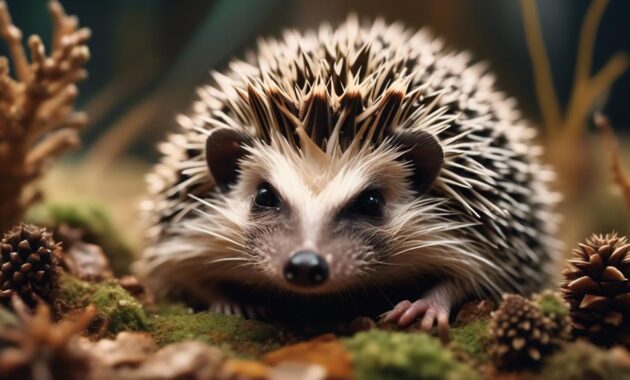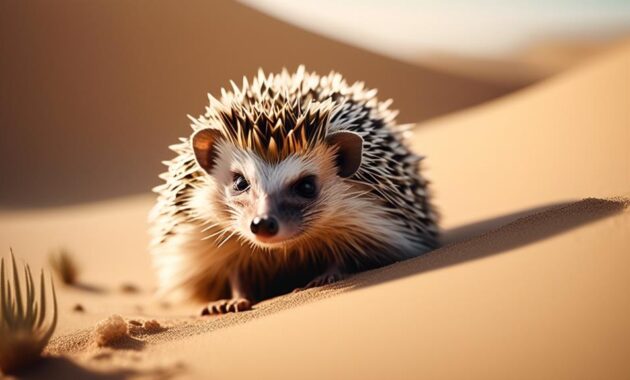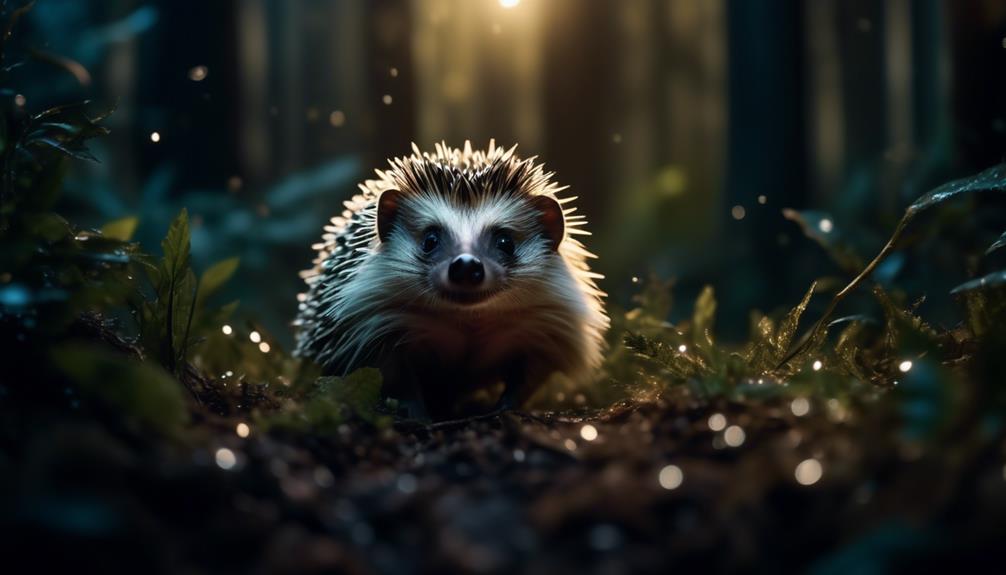
The Elusive Indian Hedgehog, a fascinating creature known for its cunning survival tactics, has managed to capture the attention of wildlife enthusiasts and researchers alike.
With its distinct physical characteristics and impressive adaptability, this small-sized species has managed to navigate its way through the challenges of its environment.
From its diverse diet to its unique defensive behavior, the Indian Hedgehog has evolved a remarkable set of skills to ensure its survival.
But what lies beneath the surface of its secretive lifestyle? What secrets does this cunning survivor hold?
Let us embark on a journey to uncover the mysteries of the Elusive Indian Hedgehog and gain a deeper understanding of its remarkable resilience.
Key Takeaways
- The Indian Hedgehog is a protected species under the Wildlife Protection Act (1972), highlighting its importance for conservation efforts.
- The hedgehog has a diverse diet, primarily consisting of insects, and has adaptations such as slowing down metabolism during food scarcity to conserve energy.
- Its defensive behaviors include rolling up into a ball, digging burrows for protection, and self-anointing to confuse predators.
- The hedgehog’s burrows serve as a central location for foraging, nesting, and raising young, ensuring the survival and growth of both mother and offspring.
Description and Physical Characteristics
The Indian hedgehog, a protected species under the Wildlife Protection Act (1972), is characterized by its masked face, dark with a white top, resembling that of a raccoon. This small mammal has a predominantly brown color with lighter shades of brown.
The adult male typically weighs around 435 grams, while the adult female weighs about 312 grams. The tail of the Indian hedgehog is relatively short, measuring only about 2-4 centimeters in length.
These hedgehogs are known for their unique physical appearance and are recognized as a protected species due to their importance in maintaining the ecological balance. Their distinctive masked face and compact body make them easily distinguishable and add to their charm as a fascinating wildlife species.
Diet and Adaptations
The Indian hedgehog’s unique physical characteristics are not only charming but also serve important purposes in its diet and adaptations.
Its diet consists of a diverse range of prey, allowing it to adapt to various environments and food availability. Here are four key aspects of the Indian hedgehog’s diet and adaptations:
- Insectivorous diet: The Indian hedgehog primarily feeds on insects, such as beetles, worms, and ants. This diet provides essential nutrients and energy for its survival.
- Adaptability: When food is scarce, the Indian hedgehog can slow down its metabolism, allowing it to conserve energy and survive for extended periods without food.
- Protective adaptations: In the face of danger, the Indian hedgehog rolls up into a ball, using its spines as a defensive mechanism. This adaptation helps protect it from predators.
- Burrow digging: The Indian hedgehog is capable of digging burrows up to 45cm long. These burrows serve as a safe haven to sleep and hide from predators.
Through its diet and adaptations, the Indian hedgehog demonstrates its remarkable ability to survive in diverse environments.
Defensive Behavior and Protection
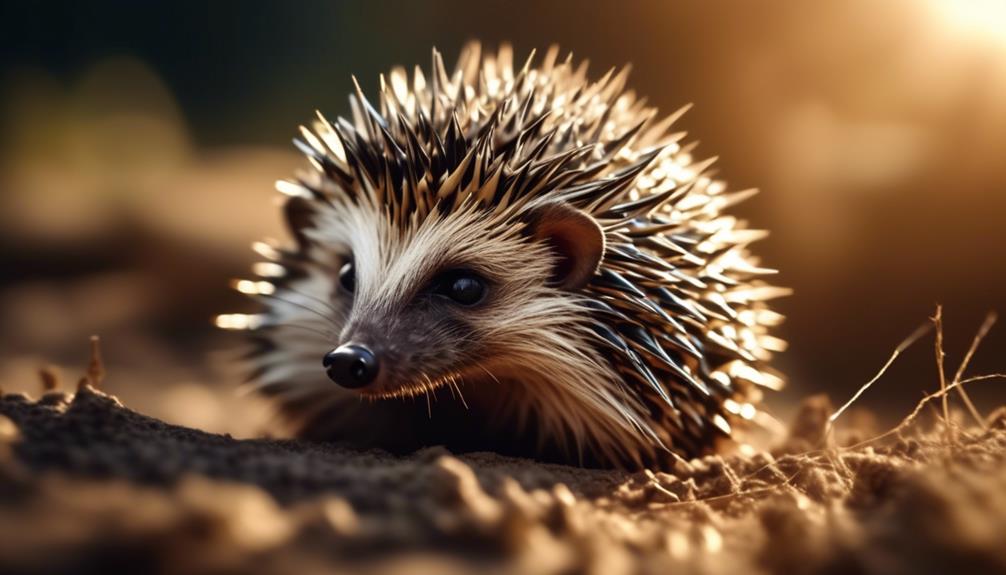
Exhibiting a range of defensive behaviors and protection mechanisms, the Indian hedgehog employs its unique physical attributes to outsmart and fend off potential threats in its environment. One of its primary defensive behaviors is rolling up into a ball when danger presents itself. By utilizing the spines on the upper side of its body, the hedgehog creates a formidable barrier against predators. Additionally, it possesses the ability to dig burrows, providing a safe haven to sleep and stay hidden from predators. The Indian hedgehog also exhibits self-anointing behavior, spreading saliva on its spines and fur after encountering unfamiliar scents or tastes, possibly as a way to confuse or deter predators. Overall, these defensive strategies showcase the Indian hedgehog’s resourcefulness and survival instincts.
| Defensive Behaviors and Protection Mechanisms |
|---|
| Rolling up into a ball |
| Digging burrows |
| Self-anointing behavior |
Burrowing and Habitat
Burrowing and habitat play essential roles in the survival and daily life of the Indian hedgehog. Here are four key aspects to consider:
- Burrow construction: Indian hedgehogs are skilled diggers, capable of creating burrows that are approximately 45cm long. These burrows serve as safe havens for sleeping and staying hidden from predators.
- Shelter and protection: The burrows provide the hedgehog with a secure habitat, shielding it from extreme temperatures and offering protection from predators. The hedgehog can retreat into its burrow and curl up into a defensive ball when danger presents itself.
- Feeding grounds: The hedgehog’s burrow is also a central location for foraging. It allows the hedgehog to access nearby food sources, such as insects, frogs, bird eggs, snakes, and scorpions, which form a significant part of its diet.
- Reproduction and raising young: Female hedgehogs use their burrows as nesting sites for giving birth to and raising their cubs. The burrows provide a safe environment for the mother and her offspring, ensuring their survival and growth.
Self-Anointing Behavior

As an integral aspect of its survival strategy, the Indian hedgehog displays a unique behavior known as self-anointing. This behavior involves the hedgehog spreading its saliva on its spines and fur after encountering unfamiliar scents or tastes. The purpose of self-anointing is still not fully understood, but it is believed to serve several functions. Firstly, it may help the hedgehog to camouflage itself by blending its scent with the environment. Secondly, it could potentially act as a form of self-medication, as the saliva may contain antimicrobial properties that help to protect against parasites or infections. Lastly, self-anointing might also serve as a way for the hedgehog to communicate with other hedgehogs, signaling its presence or reproductive status. To emphasize the different functions of self-anointing, the following table provides a clear overview:
| Function | Description |
|---|---|
| Camouflage | Blending scent with the environment to remain undetected |
| Self-medication | Potential antimicrobial properties in saliva protect against parasites or infections |
| Communication | Signaling presence or reproductive status to other hedgehogs |
Reproduction and Parenting
The reproductive behavior and parenting of Indian hedgehogs are fascinating aspects of their life cycle. Here are four key points to understand about their reproduction and parenting:
- Breeding: Male and female Indian hedgehogs come together only for breeding purposes. They do not form long-term bonds or engage in any form of parental care.
- Birth: The female Indian hedgehog gives birth to a litter of up to three cubs. These cubs are born blind, hairless, and completely dependent on their mother for survival.
- Maternal Care: Unlike some other species, the female Indian hedgehog takes on the full responsibility of raising her cubs. She provides them with warmth, protection, and nourishment until they are old enough to venture out on their own.
- Independence: Once the cubs reach a certain age, they become independent and leave their mother to establish their own territories and find mates.
Understanding these aspects of reproduction and parenting sheds light on the unique survival strategies employed by Indian hedgehogs.
Predators in the Wild
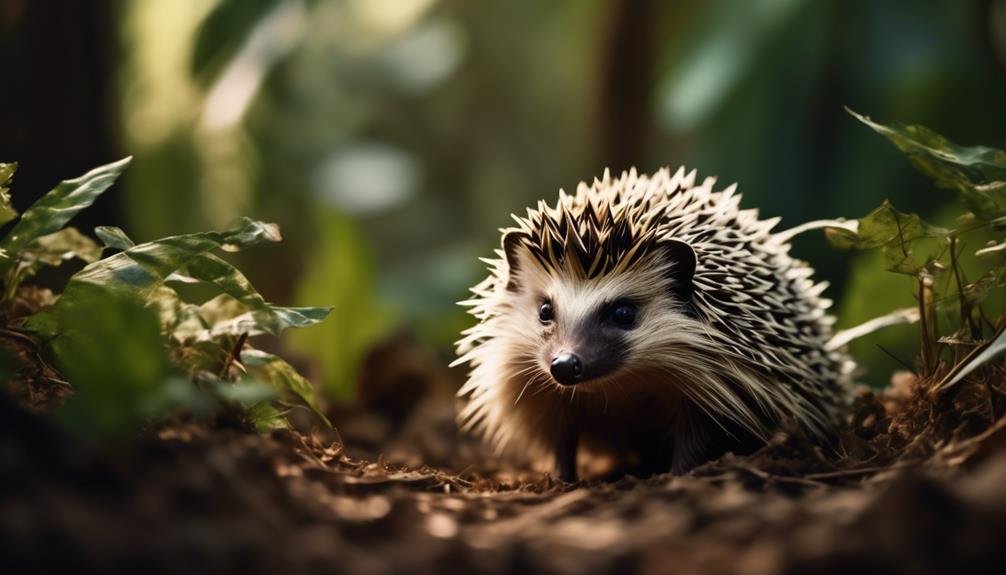
Indian hedgehogs face a range of formidable predators in their natural habitat. Foxes, Indian grey mongooses, and rock-horned owls are known to prey on these elusive creatures. These predators need to be quick and resourceful in order to catch the hedgehog before it curls up into a ball for protection.
The hedgehog’s ability to roll into a spiky ball serves as its primary defense mechanism. The spines on its upper body act as a deterrent to potential attackers. However, despite these adaptations, hedgehogs are still vulnerable to predation. Being vigilant and having a keen sense of hearing helps them to detect potential threats and avoid being caught.
The survival of Indian hedgehogs in the wild depends on their ability to outsmart and evade their predators.
Survival Strategies
To increase their chances of survival, Indian hedgehogs employ a variety of effective strategies in the face of formidable predators and challenging environmental conditions.
These survival strategies include:
- Camouflage: Indian hedgehogs have a brown coloration that helps them blend into their natural surroundings, making it harder for predators to spot them.
- Defensive mechanisms: When threatened, hedgehogs roll up into a tight ball, exposing only their spiky exterior. This makes it difficult for predators to attack them and discourages further pursuit.
- Nocturnal behavior: Indian hedgehogs are primarily active at night, reducing their exposure to predators during the day when they are more vulnerable.
- Adaptability: Hedgehogs have the ability to adjust their behaviors and habits based on the availability of food and other resources. They can slow down their metabolism and conserve energy during periods of scarcity.
Habitat and Distribution
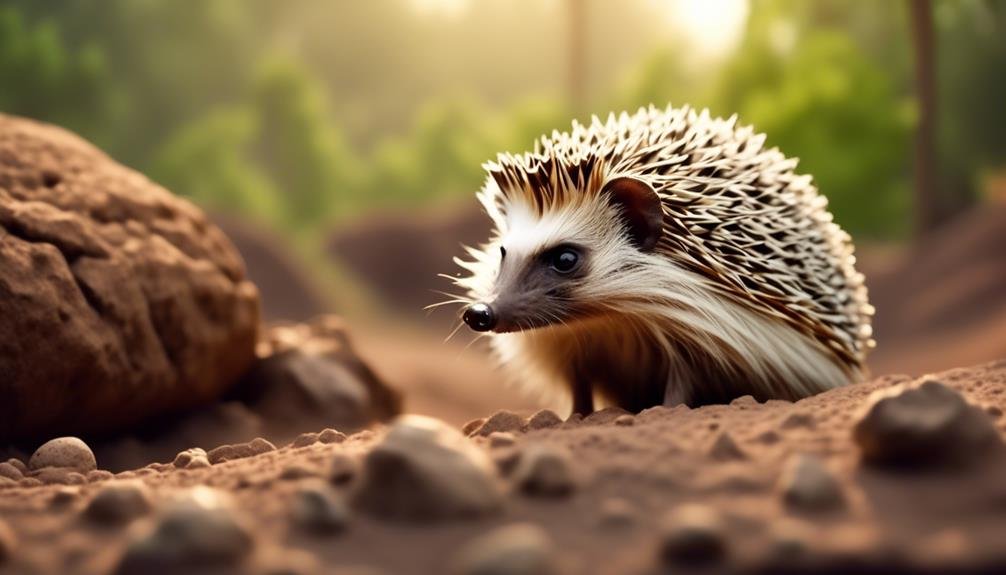
In order to survive and thrive, the elusive Indian hedgehog has adapted to a specific habitat and has a wide distribution across various regions.
This species is primarily found in the Indian subcontinent, including countries such as India, Nepal, Bangladesh, and Sri Lanka.
The Indian hedgehog is highly adaptable and can be found in a variety of habitats, including grasslands, shrublands, forests, and agricultural fields. It prefers areas with dense vegetation, as it provides ample cover and food sources.
The distribution of the Indian hedgehog is also influenced by factors such as climate, availability of food, and the presence of predators.
Despite its elusive nature, this species has managed to establish a presence in diverse habitats, showcasing its ability to survive in different environmental conditions.
Conservation Status
The conservation status of the elusive hedgehog species in India is of paramount concern to wildlife experts. The Indian hedgehog, being a protected species under Schedule IV of the Wildlife Protection Act (1972), highlights the need for its preservation. However, despite legal protection, the Indian hedgehog faces several challenges that threaten its survival.
- Habitat Loss: Rapid urbanization and deforestation have resulted in the loss of suitable habitats for the hedgehog population.
- Human-Wildlife Conflict: Encounters with humans often lead to accidental killings or capture for illegal trade.
- Road Mortality: Increased road networks pose a significant threat to hedgehogs, as they frequently fall victim to vehicular accidents.
- Lack of Awareness: Limited knowledge and awareness about the hedgehog’s ecological importance and conservation needs hinder conservation efforts.
To ensure the survival of the Indian hedgehog, it is crucial to address these challenges through effective habitat protection, public awareness campaigns, and stringent law enforcement. Only then can we secure a thriving future for this cunning survivor.
Threats and Challenges
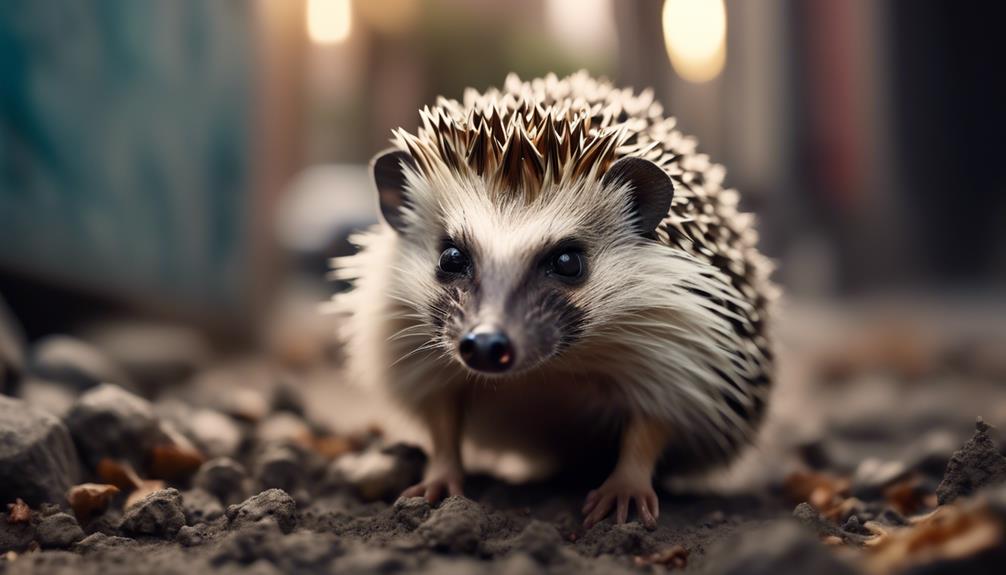
Despite legal protection and conservation efforts, the Indian hedgehog continues to face numerous threats and challenges that jeopardize its survival.
Habitat loss and degradation are major threats to the species. As urbanization and agricultural expansion continue to encroach upon its natural habitat, the hedgehog’s ability to find suitable food and shelter is severely compromised.
Additionally, road mortality poses a significant risk, as hedgehogs are often victims of traffic accidents while crossing roads in search of food or mates.
The use of pesticides and insecticides in agricultural practices also poses a threat, as it can contaminate the hedgehog’s food sources and disrupt its delicate ecosystem.
Climate change is another significant challenge, as it can alter the hedgehog’s habitat and affect its ability to find food and regulate its body temperature.
Research and Study Insights
Research and study insights have provided valuable knowledge about the elusive Indian hedgehog and its survival strategies. These insights include:
- Habitat preferences: Research has revealed that Indian hedgehogs prefer habitats with dense vegetation, such as scrublands, grasslands, and agricultural fields. Understanding their habitat preferences helps in conservation efforts and creating suitable environments for them.
- Nocturnal behavior: Studies have shown that Indian hedgehogs are primarily nocturnal, being most active during the night. This knowledge helps researchers determine the best time to study their behavior and biology.
- Home range and movements: Research has highlighted that Indian hedgehogs have relatively small home ranges, typically spanning around 10-20 hectares. They exhibit limited movements within their territories, suggesting a strong attachment to their preferred areas.
- Population dynamics: Through population studies, researchers have gained insights into the population size, density, and fluctuations of Indian hedgehogs. This information aids in assessing their conservation status and implementing effective management strategies.
Similar Species: Bare-bellied Hedgehog
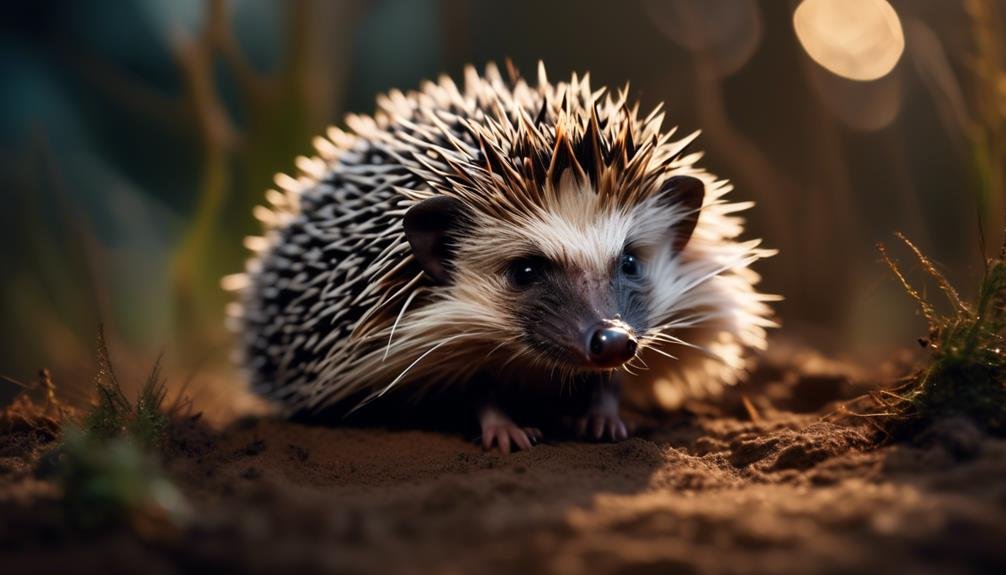
The Bare-bellied Hedgehog is another species closely related to the Indian Hedgehog, known for its distinct physical characteristics and unique adaptations. While both species belong to the same family, Erinaceidae, the Bare-bellied Hedgehog has several notable differences. Unlike the Indian Hedgehog, which has a predominantly brown coloration, the Bare-bellied Hedgehog has a bare belly with visible skin. It also has longer quills compared to its counterpart. Additionally, the Bare-bellied Hedgehog is known for its ability to roll up into a tight ball when threatened, providing a formidable defense mechanism. This species is found in regions of Pakistan, Afghanistan, and Iran. Table 1 provides a visual comparison between the Indian Hedgehog and the Bare-bellied Hedgehog.
| Physical Characteristics | Indian Hedgehog | Bare-bellied Hedgehog |
|---|---|---|
| Color | Predominantly brown with lighter shades of brown | Bare belly with visible skin |
| Quill Length | Short | Longer |
| Ability to Roll into a Ball | Yes | Yes |
| Habitat | India, Nepal, and Sri Lanka | Pakistan, Afghanistan, Iran |
Interactions With Humans
Interacting closely with human populations, the elusive Indian hedgehog has managed to navigate its way through urban environments while maintaining its secretive and solitary nature. Despite its ability to coexist with humans, there are several important interactions between the Indian hedgehog and humans that deserve attention:
- Habitat destruction: As urban areas expand, the natural habitats of Indian hedgehogs are being destroyed, leading to a loss of suitable living spaces for these creatures.
- Road accidents: Hedgehogs are often victims of road accidents, as they frequently cross roads in search of food or mates.
- Human-wildlife conflict: In some cases, Indian hedgehogs may enter human properties in search of food or shelter, leading to conflicts with humans who may view them as pests.
- Conservation efforts: Efforts are underway to raise awareness about the importance of protecting the Indian hedgehog and its habitat, as well as implementing measures to minimize human-wildlife conflicts and promote coexistence.
Through understanding and addressing these interactions, we can ensure the survival and well-being of this remarkable species in our changing world.
Tips for Wildlife Enthusiasts
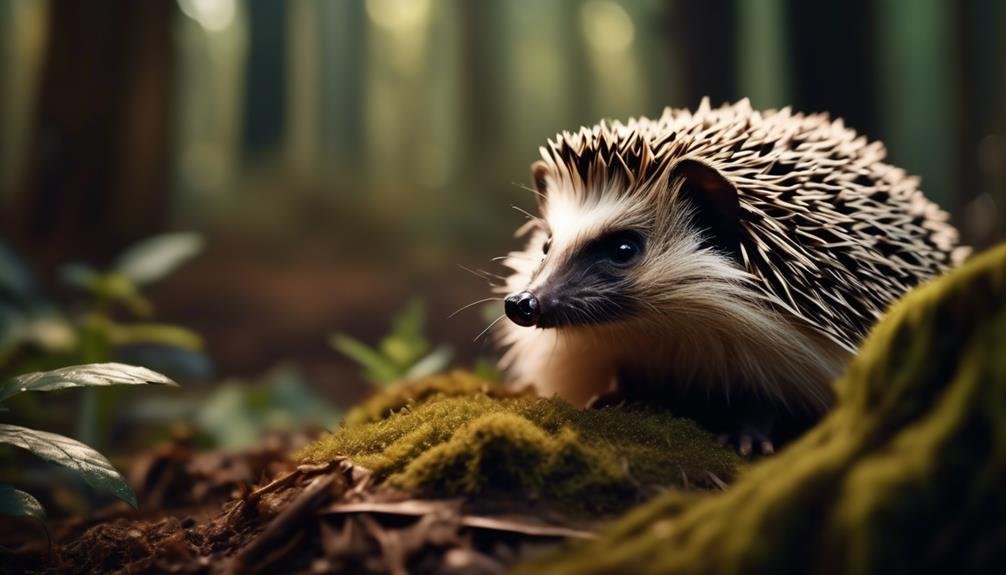
For wildlife enthusiasts seeking to observe and engage with the captivating world of nature, here are some valuable tips to enhance your experiences and ensure the well-being of the wildlife you encounter.
- Respect their habitat: Wildlife relies on their natural environment for survival. Avoid disturbing their homes and nesting areas, and stay on designated trails to minimize your impact.
- Observe from a distance: Maintain a safe distance from wildlife to avoid causing stress or interfering with their natural behavior. Use binoculars or zoom lenses to get a closer look without disturbing them.
- Do not feed the animals: Feeding wildlife can disrupt their natural diet and behavior, and may lead to dependency or aggression. Let them find their own food sources.
- Do not touch or approach: Wild animals are unpredictable and may perceive your approach as a threat. Keep a safe distance and never attempt to touch or handle them.
- Leave no trace: Dispose of your trash properly and minimize your impact on the environment. Respect the wildlife’s home by leaving it as you found it.
Frequently Asked Questions
How Long Do Indian Hedgehogs Live in the Wild?
Indian hedgehogs typically live for about 4-6 years in the wild. Factors such as predation, availability of food, and habitat conditions can influence their lifespan. These elusive creatures adapt well to their surroundings, making them cunning survivors.
What Is the Main Threat to the Survival of Indian Hedgehogs?
The main threat to the survival of Indian hedgehogs is habitat loss due to deforestation and urbanization. This disrupts their natural habitat and food sources, making it difficult for them to find suitable places to live and thrive.
Do Indian Hedgehogs Have Any Natural Predators Aside From Foxes, Indian Grey Mongooses, and Rock-Horned Owls?
Yes, aside from foxes, Indian grey mongooses, and rock-horned owls, Indian hedgehogs do not have any known natural predators. Their ability to curl up into a ball provides them with effective protection against potential threats.
Are There Any Known Cases of Indian Hedgehogs Attacking Humans?
There are no known cases of Indian hedgehogs attacking humans. These animals are generally harmless and avoid human contact. However, it is important to treat all wildlife with caution and respect their natural behaviors and habitats.
Can Indian Hedgehogs Be Kept as Pets?
Indian hedgehogs can be kept as pets, but they require specialized care. They have specific dietary needs, need a suitable enclosure, and require regular veterinary check-ups. It is important to research and understand their needs before considering them as pets.
What Strategies Do Indian Hedgehogs Use to Survive in the Wild?
The amur hedgehog population in India relies on various survival strategies in the wild. They primarily use their sharp spines to protect themselves from predators. Additionally, they are nocturnal animals, which helps them avoid potential threats during the day. Their diet consists of insects and small creatures, ensuring a steady food source.
Conclusion
In conclusion, the Indian Hedgehog is a fascinating creature with distinct physical characteristics and remarkable survival strategies. Its diverse diet and ability to slow down metabolism during food scarcity showcase its adaptability.
The hedgehog’s defensive behavior of curling up into a protective ball and utilizing its spines for defense is a unique trait. Its burrowing habits and habitat preferences contribute to its survival in the wild.
Further research and study insights can help in conservation efforts. Understanding the Indian Hedgehog and its interactions with humans can promote wildlife conservation.

